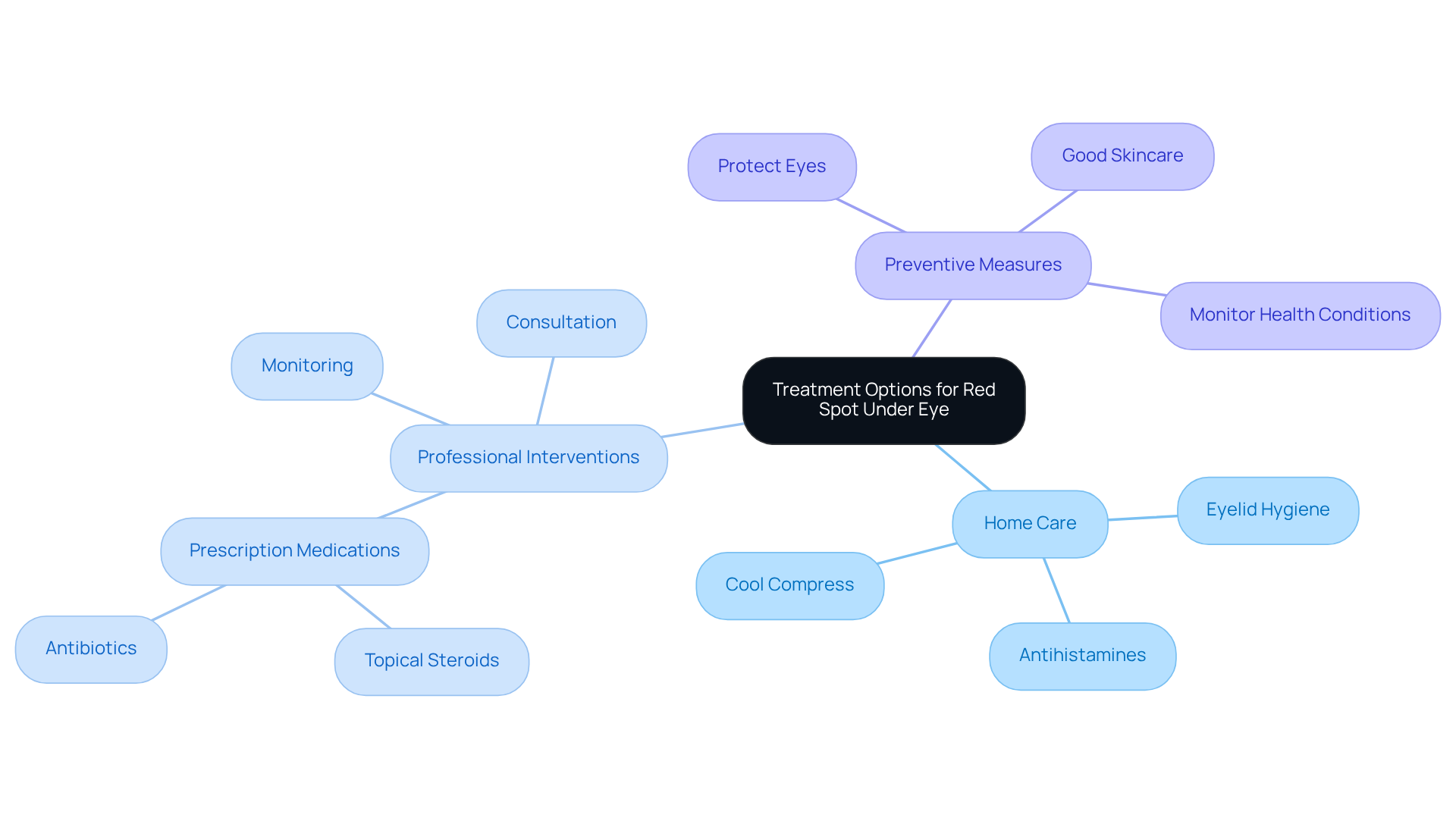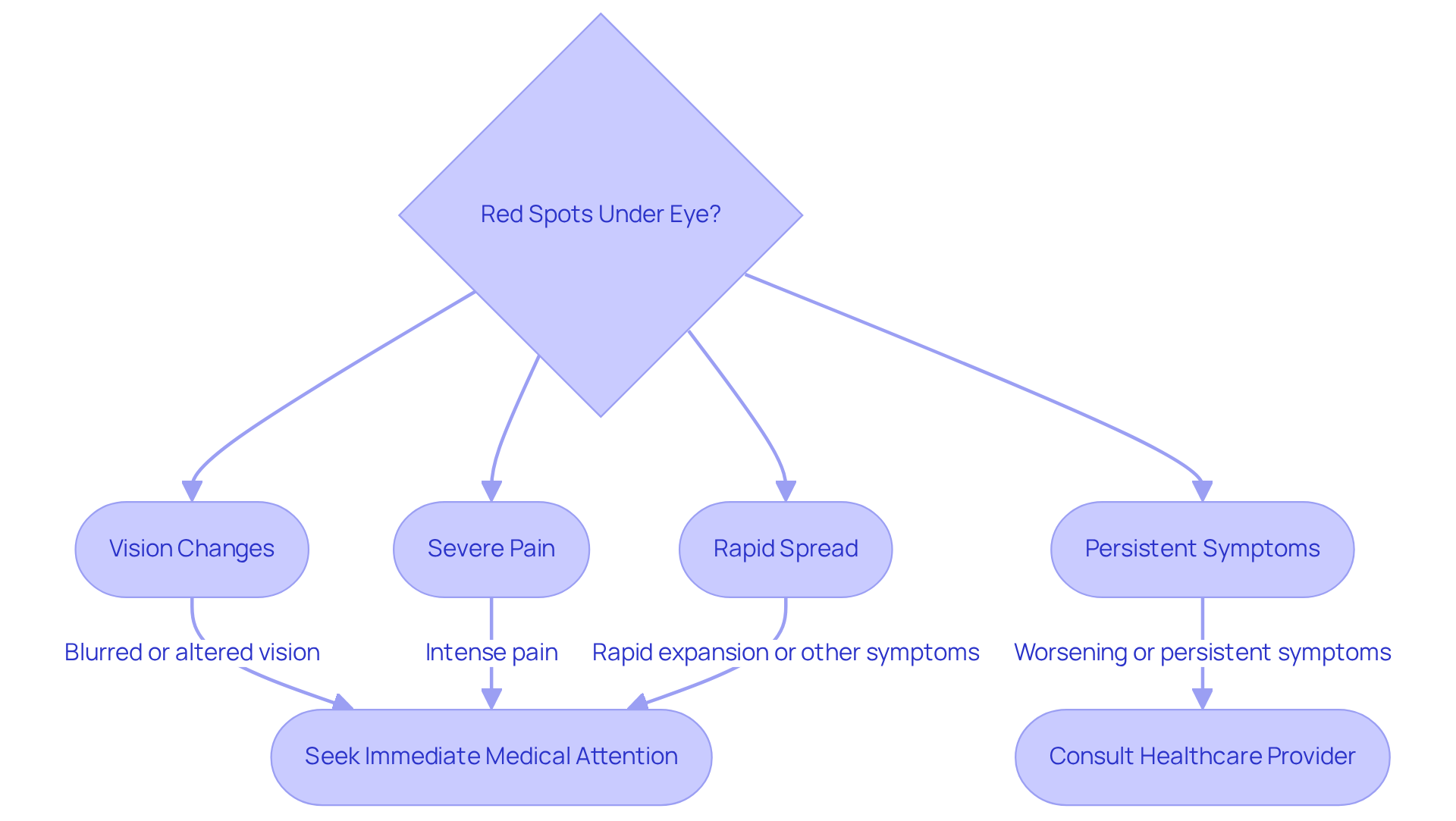Posted by: Northwest Eye in General on November 15, 2025
Introduction
Noticing red spots under the eye can understandably evoke concern. These marks may signal underlying health issues, ranging from minor irritations to more serious conditions. We understand that this can be alarming, and it’s important to know that you’re not alone in feeling this way.
Understanding the various causes – whether medical, environmental, or due to injuries – can empower you to take appropriate action. It’s common to feel uncertain about when to seek professional help and what treatment options are available. This exploration delves into the significance of red spots under the eye, offering insights into their causes, potential treatments, and crucial indicators that warrant immediate medical attention.
We are here to help you through this process, providing the information you need to feel more secure and informed.
Define Red Spots Under the Eye: Significance and Overview
A red spot under eye can take on various forms, such as petechiae, subconjunctival hemorrhages, and other skin conditions. We understand that noticing a red spot under eye can be concerning, and it’s important to recognize its significance, as it may indicate underlying health issues like blood vessel rupture, allergic reactions, or skin conditions.
For example, petechiae are small, painless spots caused by bleeding beneath the skin. They often arise from minor injuries, physical strain, or certain medical conditions. While petechiae can be harmless, we want to emphasize that persistent marks or those accompanied by other symptoms should be evaluated by a healthcare professional.
Subconjunctival hemorrhages typically appear as bright red patches on the white part of the eye. The good news is that they usually resolve on their own within a few days to weeks, often resulting from minor trauma or strain, like sneezing or coughing. Identifying the characteristics of these marks is crucial for determining the best response and treatment options.
To help prevent irritation and manage existing conditions, maintaining proper hygiene and using gentle skincare products is advisable. If you notice that the redness associated with the red spot under your eye persists or changes in appearance, we encourage you to consult a healthcare provider. It’s always better to rule out any serious underlying issues. Remember, we are here to help you through this process.

Explore Causes of Red Spots: Medical and Environmental Factors
Red spots under the eye can arise from various causes, and we understand how concerning a red spot under the eye can be. Here are some common reasons:
-
Medical Conditions: Conditions like conjunctivitis and allergic reactions are often the culprits. Allergic conjunctivitis affects 15% to 40% of the population, leading to redness and irritation. Skin disorders, such as periocular dermatitis, can also contribute to these symptoms. Subconjunctival hemorrhages, which can occur from sneezing or straining, happen when blood collects beneath the conjunctiva, forming a visible red mark.
-
Environmental Factors: Exposure to irritants like smoke, pollution, or harsh skincare products can trigger inflammation and redness. Seasonal allergies, which impacted about 25.7% of adults in 2021, can worsen these conditions. Additionally, extreme weather-whether hot or cold-can heighten skin sensitivity, resulting in red marks around the face. In fact, 31.8% of adults aged 18 and over had a seasonal allergy in 2021, highlighting how common this issue is.
-
Injuries: Minor trauma to the area around the eyes, such as rubbing them or unintentional bumps, can lead to broken blood vessels, resulting in red marks. This is particularly common in children, where the first peak of acute conjunctivitis incidence occurs in those under 7 years old. As S Bhimji notes, “Determining the cause of conjunctivitis can be challenging as its symptoms are not specific,” which underscores the importance of a thorough evaluation.
Understanding these factors is essential for effective management and treatment of the red spot under the eye. Remember, we are here to help you through this process.

Discuss Treatment Options: Home Care and Professional Interventions
Treatment for a red spot under eye can vary significantly based on the underlying cause, and we understand how concerning this can be. It’s essential to approach this with a customized plan for effective management.
Home Care: For minor irritations, applying a cool compress can be a soothing way to reduce swelling and calm the skin. We encourage maintaining good eyelid hygiene through gentle cleansing to prevent further irritation. If allergies are causing discomfort, over-the-counter antihistamines may provide relief.
If a red spot under the eye persists or is accompanied by pain or changes in vision, it’s crucial to consult a healthcare professional. Treatments may include prescription medications, such as topical steroids to address inflammation or antibiotics for infections. In cases of subconjunctival hemorrhage, reassurance and monitoring are often sufficient, as this condition typically resolves on its own within a few days to weeks. We’ve seen that individuals facing ongoing redness or discoloration, particularly a red spot under eye, should seek medical advice for suitable treatment options, which may include antibiotics, corticosteroids, topical creams, or self-care remedies.
Preventive Measures: To minimize the risk of future occurrences, it’s advisable to protect your eyes from environmental irritants, practice good skincare, and avoid excessive rubbing or straining. Regular monitoring for bleeding disorders is also recommended for those experiencing frequent eye blood marks, as managing underlying health conditions can significantly lower the risk of complications. Remember, timely professional interventions can lead to improved outcomes, so don’t hesitate to seek medical advice when necessary.

Identify When to Seek Medical Care: Recognizing Urgent Symptoms
While many red spots under the eye are harmless, we understand that certain symptoms can be concerning and require immediate medical attention:
-
Vision Changes: If red spots are accompanied by blurred or altered vision, it may indicate a more serious condition, such as retinal detachment, uveitis, cataracts, or diabetic retinopathy. These conditions can lead to permanent vision loss if not addressed promptly, and we want to reassure you that seeking help is crucial.
-
Severe Pain: Intense pain in the eye or surrounding area should not be ignored. It could signal an infection, such as scleritis or keratitis, or an injury that requires urgent care. Notably, 50% of individuals with anterior scleritis have related autoimmune systemic illness, highlighting the potential severity of these indications. Remember, you are not alone in this; many have faced similar challenges.
-
Rapid Spread: If a red spot under eye expands swiftly or is associated with other symptoms like fever, dizziness, or difficulty breathing, please seek emergency care. These could be signs of systemic infections or allergic reactions that need immediate intervention. It’s common to feel anxious in these situations, but prompt action can make a difference.
-
Persistent Symptoms: If a red spot under eye does not improve with home care or worsens over time, it is essential to consult a healthcare provider for further evaluation and treatment. While most minor subconjunctival hemorrhages resolve in 1 to 2 weeks without complications, ongoing signs could suggest underlying problems that necessitate professional evaluation. We encourage you to reach out for support when needed.
Identifying these urgent signs can significantly affect the preservation of vision and overall eye health. As noted by the Ophthalmology Associates of Bay Ridge, “If the redness is accompanied by eye pain, this could indicate an infection or other serious condition.” Additionally, the case study titled “Importance of Timely Eye Care” emphasizes that symptoms like pain, blurred vision, and swelling necessitate prompt evaluation. We are here to help you through this process.

Conclusion
Recognizing and understanding red spots under the eye is crucial for maintaining your eye health and overall well-being. We understand that noticing these marks can be concerning, as they can stem from various causes, including medical conditions, environmental factors, and minor injuries. Being aware of their significance allows for timely intervention, whether through home care strategies or professional medical assistance.
This article explored a range of causes for red spots, highlighting conditions like conjunctivitis and allergic reactions, as well as environmental irritants and trauma. Treatment options vary based on the underlying cause. For minor issues, home care methods, such as cool compresses and antihistamines, can be quite effective. However, if you experience persistent or concerning symptoms, it’s important to visit a healthcare provider for further evaluation and potential treatment.
Ultimately, being proactive about your eye health is essential. Regularly monitoring any changes, understanding when to seek medical care, and taking preventive measures can significantly enhance your outcomes. By staying informed and attentive, you can effectively manage red spots under the eye and safeguard your vision. Remember, we are here to help you through this process.
Frequently Asked Questions
What are red spots under the eye, and what forms can they take?
Red spots under the eye can take various forms, including petechiae, subconjunctival hemorrhages, and other skin conditions.
What could a red spot under the eye indicate?
A red spot under the eye may indicate underlying health issues such as blood vessel rupture, allergic reactions, or skin conditions.
What are petechiae, and what causes them?
Petechiae are small, painless spots caused by bleeding beneath the skin. They can arise from minor injuries, physical strain, or certain medical conditions.
Are petechiae harmful?
While petechiae can be harmless, persistent marks or those accompanied by other symptoms should be evaluated by a healthcare professional.
What are subconjunctival hemorrhages, and how do they appear?
Subconjunctival hemorrhages appear as bright red patches on the white part of the eye and usually result from minor trauma or strain, such as sneezing or coughing.
How long do subconjunctival hemorrhages typically last?
Subconjunctival hemorrhages usually resolve on their own within a few days to weeks.
What should I do if I notice a persistent red spot under my eye?
If the redness associated with the red spot persists or changes in appearance, it is advisable to consult a healthcare provider to rule out any serious underlying issues.
How can I manage or prevent irritation related to red spots under the eye?
Maintaining proper hygiene and using gentle skincare products can help prevent irritation and manage existing conditions.






